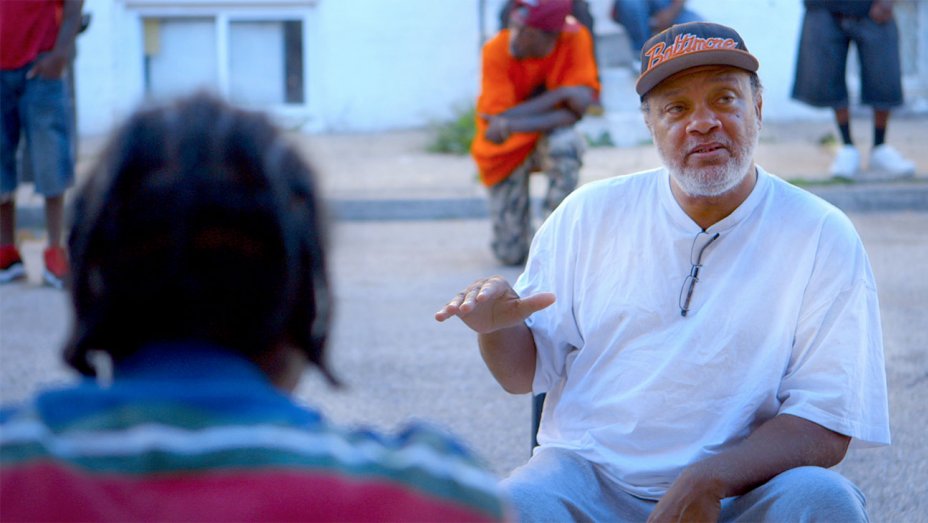
New documentary shines light on Baltimore, Black lives, and police
By: Matt McDonald, Columnist
Featured image courtesy of hollywoodreporter.com
“Charm City” is a documentary about an ongoing problem our nation faces today: the struggle between African Americans and the police. Giving an inside look at the everyday lives of those on either end, and the struggles and heartbreak that comes with them, this film raises more questions and issues than it does answers and solutions.
The film tracks several storylines, interweaving them so thoughtfully, the audience is called to seriously reflect on these issues. The lives include a community living on Rose Street, especially Alex Long, a huge enforcer of street cleaning and children’s education and well-being, and Clayton “Mr. C” Guyton, the neighborhood’s fatherly figure that keeps everybody on the right path; the local police station, especially Officer Eric Winston and Major Monique Brown, someone who has been on both sides, growing up in the area but now on the force; and Councilman Brandon Scott, the youngest elected official to that position.
“Charm City” is definitely the film we need right now. By the end, I’d found myself so wrapped up in the stories and found the issues so nationally common, I’d completely forgotten this is happening all in my hometown. On one side, there’s the community on Rose Street, who could not be more of a family, having morning meetings and prayer sessions, giving the kids resources, and helping and supporting each other in tragedy. When they’ve decided the police do not do enough and seem to not care about the bigger issues, they take it upon themselves to keep the streets not only clean, but safe. On the other side, you have the police, who are constantly on patrol, wanting to see the city safe, and engaging with the community, but also have the evidence of acting unjustly without cause, accusing with no proof, and stereotyping and profiling. Finally, there is Scott, who is in the middle of it all, trying to do what he can to bring together the two sides and settle these issues.
There are many shocking moments in this documentary. Many tragic, frustrating, and enraging moments. But there are also hopeful ones. My favorite moment was when an officer was observing a huddled group of people around what might have been something illegal, but they were just playing chess on the stairs. Not only did this show how quickly we can assume, but it showed a great moment of the two sides interacting positively. I’m glad the filmmakers showed both sides thoroughly, the struggles both sides endure, how it’s not on one person or another, but the community as a whole. It shows there are major flaws in the system that need to be fixed, or at least acknowledged and worked on, and, as one scene shows, this can only begin to happen by bringing together both sides and having those conversations, big or small.
I loved this documentary, how relevant and necessary it is right now, and how credible it is, just presenting the stories and letting them do the talking. It’s beautifully shot, very moving, and most importantly, incredibly empowering and motivating to start taking some action, even if it’s just with a simple conversation.
___________________________
On Oct. 2, I had the opportunity to interview the director of “Charm City,” Marilyn Ness, as well as two of the film’s subjects, Rose Street citizen Alex Long and Major Monique Brown at the Parkway Theater in Baltimore.
I started off by asking what it took to make a documentary, both from on camera and behind it. Ness said that it takes not only “radical patience,” but that as a director of a documentary, in which there is a mixture of narrative preparation and real-life spontaneity, you have to hope you have the camera pointed the right way and that the story unfolds. Ness stressed that making a documentary involves being open with the subjects and spending time with them beforehand to create that mutual trust.
Long emphasized this trust, adding that when that bond exists, and the subjects are comfortable, it’s easy—people will genuinely be themselves. He also commented that when the cameras began rolling, it was like hide-and-go-seek, and the many people in the house suddenly became only a few. Lastly, Brown brought up that courage is definitely necessary to make sure that these new stories need to be told to the world, not in a negative light, but in a hopeful one, and vulnerability is critical to this.
I then asked what it was that kept each of them motivated, especially in times of struggle or tragedy. Long jumped right in, stating that the struggles and tragedy are his motivation. He pointed out that there is always work; it’s never-ending. He concentrates his focus on the youth, the next generation, who he believes are the key to changing things. He said that film shows that all are victims, that we all have similar stories and motivations to become who we are and what we do. He said that people pay too much attention to what brings out their demons, and not on finding ways to turn them around positively; we need caring from others to give balance and help guide each other.
Brown agreed with a need for passion towards youth and specifically African American youth.
“What do we do to fix it?” she asked. Her answer was focusing on rebuilding that foundation between all citizens, that learning and understanding situations, and not making assumptions is important. Like Long, Brown talked about having resources or getting someone services to motivate them to leave what is negatively affecting their lives.
Finally, Ness stressed the amazing quality that the subjects of the documentary, and any who have gone through similar struggles, displayed in facing hardships and pain. One person can make a difference, and Ness knows film can show that and the contexts through which we see it.
I lastly asked each of them what they love about Baltimore and what they would like to see changed. Long said that he would like to get rid of the crab logo, and while it was in good humor, on a deeper level, he wanted to get rid of the logos that have negative thoughts of Baltimore connected to it. He wants people to hear about the good things Baltimore has to offer, and to make it and the whole state better.
Ness said once more that individual acts can bring about these changes, and that there is a light here in Baltimore, and it can be brought out. Brown admires the community of Baltimore, finding those diamonds in the rough who will contribute to that community. She wants people to “stop killing each other” and find those great people that will help repair and rebuild that foundation.
“Become the change agent to make the change,” Brown said.
It was an incredible opportunity to meet these people in person and hear them speak about what this documentary and city meant to them in their own words. I couldn’t agree more about the light in Baltimore, and if we can make it shine as bright as the actual lights in the Harbor or the city at night time, we’ll have a great city to show for it.

